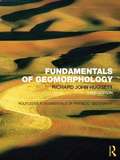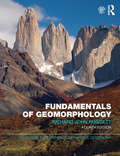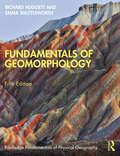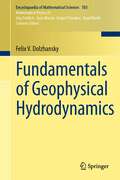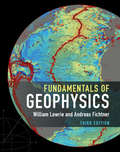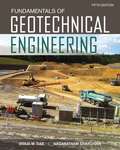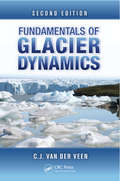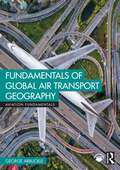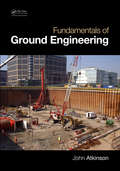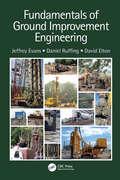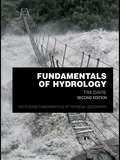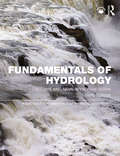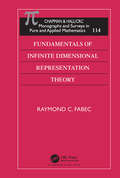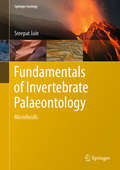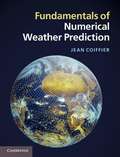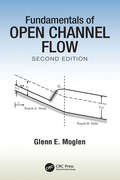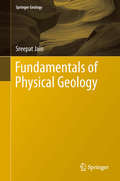- Table View
- List View
Fundamentals of Geomorphology
by Richard John HuggettThis extensively revised, restructured, and updated edition continues to present an engaging and comprehensive introduction to the subject, exploring the world's landforms from a broad systems perspective. It covers the basics of Earth surface forms and processes, while reflecting on the latest developments in the field. Fundamentals of Geomorphology begins with a consideration of the nature of geomorphology, process and form, history, and geomorphic systems, and moves on to discuss: structure: structural landforms associated with plate tectonics and those associated with volcanoes, impact craters, and folds, faults, and joints process and form: landforms resulting from, or influenced by, the exogenic agencies of weathering, running water, flowing ice and meltwater, ground ice and frost, the wind, and the sea; landforms developed on limestone; and landscape evolution, a discussion of ancient landforms, including palaeosurfaces, stagnant landscape features, and evolutionary aspects of landscape change. This third edition has been fully updated to include a clearer initial explanation of the nature of geomorphology, of land surface process and form, and of land-surface change over different timescales. The text has been restructured to incorporate information on geomorphic materials and processes at more suitable points in the book. Finally, historical geomorphology has been integrated throughout the text to reflect the importance of history in all aspects of geomorphology. Fundamentals of Geomorphology provides a stimulating and innovative perspective on the key topics and debates within the field of geomorphology. Written in an accessible and lively manner, it includes guides to further reading, chapter summaries, and an extensive glossary of key terms. The book is also illustrated throughout with over 200 informative diagrams and attractive photographs, all in colour.
Fundamentals of Geomorphology
by Richard John HuggettThe new fourth edition of Fundamentals of Geomorphology continues to provide a comprehensive introduction to the subject by discussing the latest developments in the field, as well as covering the basics of Earth surface forms and processes. The revised edition has an improved logically cohesive structure, added recent material on Quaternary environments and landscapes, landscape evolution and tectonics, as well as updated information in fast-changing areas such as the application of dating techniques, digital terrain modelling, historical contingency, preglacial landforms, neocatastrophism, and biogeomorphology. The book begins with a consideration of the nature of geomorphology, process and form, history, and geomorphic systems, and moves on to discuss: Endogenic processes: structural landforms associated with plate tectonics and those associated with volcanoes, impact craters, and folds, faults, and joints. Exogenic processes: landforms resulting from, or influenced by, the exogenic agencies of weathering, running water, flowing ice and meltwater, ground ice and frost, the wind, and the sea; landforms developed on limestone; and long-term geomorphology, a discussion of ancient landforms, including palaeosurfaces, stagnant landscape features, and evolutionary aspects of landscape change. Featuring over 400 illustrations, diagrams, and tables, Fundamentals of Geomorphology provides a stimulating and innovative perspective on the key topics and debates within the field of geomorphology. Written in an accessible and lively manner, and providing guides to further reading, chapter summaries, and an extensive glossary of key terms, this is an indispensable undergraduate level textbook for students of physical geography.
Fundamentals of Geomorphology (Routledge Fundamentals of Physical Geography)
by Richard Huggett Emma ShuttleworthThis revised and updated edition continues to provide a comprehensive introduction to the subject, exploring the world’s landforms from a broad systems perspective. It covers the basics of Earth surface forms and processes, while reflecting on the latest developments in the field. Fundamentals of Geomorphology begins with a consideration of the nature of geomorphology, including its relation to society, process and form, history, and geomorphic systems, and moves on to discuss: • Structure: structural landforms associated with plate tectonics and those associated with volcanoes, and folds, faults, and joints. • Process and form: landforms resulting from, or influenced by, the exogenic agencies of weathering, running water, flowing ice and meltwater, ground ice and frost, the wind, and the sea; landforms developed on limestone; extraterrestrial landforms; and landscape evolution, a discussion of ancient landforms. Fundamentals of Geomorphology provides a stimulating and innovative perspective on the key topics and debates within the field of geomorphology. Written in an accessible and lively manner, it includes guides to further reading, chapter summaries, and an extensive glossary of key terms. The book is also illustrated throughout with over 200 informative diagrams and attractive photographs, all in colour. It is supported by online resources for students and instructors.
Fundamentals of Geophysical Hydrodynamics
by Boris Khesin E. B. Gledzer Felix V. Dolzhansky A. E. GledzerThis newly-translated book takes the reader from the basic principles and conservation laws of hydrodynamics to the description of general atmospheric circulation. Among the topics covered are the Kelvin, Ertel and Rossby-Obukhov invariants, quasi-geostrophic equation, thermal wind, singular Helmholtz vortices, derivation of the Navier-Stokes equation, Kolmogorov's flow, hydrodynamic stability, and geophysical boundary layers. Generalizing V. Arnold's approach to hydrodynamics, the author ingeniously brings in an analogy of Coriolis forces acting on fluid with motion of the Euler heavy top and shows how this is used in the analysis of general atmospheric circulation. This book is based on popular graduate and undergraduate courses given by F.V.Dolzhansky at the Moscow Institute of Physics and Technology, and is the result of the author's highly acclaimed work in Moscow's Laboratory of Geophysical Hydrodynamics. Each chapter is full of examples and figures, exercises and hints, motivating and illustrating both theoretical and experimental results. The exposition is comprehensive yet user-friendly in engaging and exploring the broad range of topics for students and researchers in mathematics, physics, meteorology and engineering.
Fundamentals of Geophysics
by William Lowrie Andreas FichtnerThis enduringly popular undergraduate textbook has been thoroughly reworked and updated, and now comprises twelve chapters covering the same breadth of topics as earlier editions, but in a substantially modernized fashion to facilitate classroom teaching. Covering both theoretical and applied aspects of geophysics, clear explanations of the physical principles are blended with step-by-step derivations of the key equations and over 400 explanatory figures to explain the internal structure and properties of the planet, including its petroleum and mineral resources. New topics include the latest data acquisition technologies, such as satellite geophysics, planetary landers, ocean bottom seismometers, and fibre optic methods, as well as recent research developments in ambient noise interferometry, seismic hazard analysis, rheology, and numerical modelling - all illustrated with examples from the scientific literature. Student-friendly features include separate text boxes with auxiliary explanations and advanced topics of interest; reading lists of foundational, alternative, or more detailed resources; end-of-chapter review questions and an increased number of quantitative exercises. Completely new to this edition is the addition of computational exercises in Python, designed to help students acquire important programming skills and develop a more profound understanding of geophysics.
Fundamentals of Geophysics
by William LowrieThis textbook presents a comprehensive overview of the fundamental principles of geophysics. It combines applied and theoretical aspects of the subject, in contrast to most other geophysics textbooks which tend to emphasise either one or the other. The author explains complex geophysical concepts using abundant diagrams, a simplified mathematical treatment, and easy-to-follow equations. After placing the Earth in the context of the solar system, it describes each major branch of geophysics: gravitation, seismology, dating, thermal and electrical properties, geomagnetism, palaeomagnetism and geodynamics. Each chapter begins with a summary of the basic physical principles, and a brief account of each topic's historical evolution. Pitched at a level between introductory and advanced texts, the book will satisfy the needs of intermediate-level earth science students from a variety of backgrounds, while at the same time preparing geophysics majors for continued study to a higher level. The book is destined to become a core textbook for geology and geophysics courses.
Fundamentals of Geotechnical Engineering
by Nagaratnam Sivakugan Braja DasFUNDAMENTALS OF GEOTECHNICAL ENGINEERING, 5E offers a powerful combination of essential components from Braja Das' market-leading books: PRINCIPLES OF GEOTECHNICAL ENGINEERING and PRINCIPLES OF FOUNDATION ENGINEERING in one cohesive book. This unique, concise geotechnical engineering book focuses on the fundamental concepts of both soil mechanics and foundation engineering without the distraction of excessive details or cumbersome alternatives. A wealth of worked-out, step-by-step examples and valuable figures help readers master key concepts and strengthen essential problem solving skills. Prestigious authors Das and Sivakugan maintain the careful balance of today's most current research and practical field applications in a proven approach that has made Das' books leaders in the field.
Fundamentals of Glacier Dynamics
by C.J. van der VeenMeasuring, monitoring, and modeling technologies and methods changed the field of glaciology significantly in the 14 years since the publication of the first edition of Fundamentals of Glacier Dynamics. Designed to help readers achieve the basic level of understanding required to describe and model the flow and dynamics of glaciers, this second edi
Fundamentals of Global Air Transport Geography (Aviation Fundamentals)
by George ArbuckleThe commercial air transport industry can be broadly split into three component parts: airlines, airports and aircraft. Each of these components is shaped by geography, insofar as each is influenced by places, landscapes, environments, people and their various interactions. Conversely, air transport plays a large role in shaping the various themes of geography and the position of our physical, human and environmental world. It connects people, cultures and businesses across every continent and generates economic growth, allows international trade to occur and develops tourism. It can also be involved in creating negative outputs, such as emissions, noise and loss of biodiversity, which can have a large impact on the planet and quality of life. A lack of air transport links can also have a significantly negative impact on world regions in terms of economic and cultural development. In short, air transport and geography are inextricably linked.Fundamentals of Global Air Transport Geography details the geography of the global commercial air transport industry. The book aims to provide an understanding of these key areas at an introductory level, in order to be accessible to students and non-technical airport/airline management. A key theme throughout the book will not only be how geographical issues have influenced air transport, but also how air transport continues to influence geography. Each chapter boasts a range of features aimed at enhancing the reader’s understanding, including learning objectives, discussion questions and case studies, and lecturers can find supporting resources including PowerPoint slides and teaching notes online.
Fundamentals of Ground Engineering
by John AtkinsonFundamentals of Ground Engineering is an unconventional study guide that serves up the key principles, theories, definitions, and analyses of geotechnical engineering in bite-sized pieces. This book contains brief-one or two pages per topic-snippets of information covering the geotechnical engineering component of a typical undergraduate course in
Fundamentals of Ground Improvement Engineering
by David Elton Jeffrey Evans Daniel RuffingGround improvement has been one of the most dynamic and rapidly evolving areas of geotechnical engineering and construction over the past 40 years. The need to develop sites with marginal soils has made ground improvement an increasingly important core component of geotechnical engineering curricula. Fundamentals of Ground Improvement Engineering addresses the most effective and latest cutting-edge techniques for ground improvement. Key ground improvement methods are introduced that provide readers with a thorough understanding of the theory, design principles, and construction approaches that underpin each method. Major topics are compaction, permeation grouting, vibratory methods, soil mixing, stabilization and solidification, cutoff walls, dewatering, consolidation, geosynthetics, jet grouting, ground freezing, compaction grouting, and earth retention. The book is ideal for undergraduate and graduate-level university students, as well as practitioners seeking fundamental background in these techniques. The numerous problems, with worked examples, photographs, schematics, charts and graphs make it an excellent reference and teaching tool.
Fundamentals of Hydrology
by Tim DavieIn order to manage the world's increasingly scarce water resources we must have a sound understanding of how water moves around the planet and what influences water quality. Fundamentals of Hydrology provides an engaging and comprehensive introduction to this subject and provides real-life examples of water resource management in a changing world. The second edition of this popular book brings the text up-to-date with additional case studies and diagrams and a greater synthesis of water quality with physical hydrology. The chapters on runoff and evaporation have been updated and the final chapter on hydrology in a changing world has more material on water resource management strategies. Additionally the chapter on streamflow analysis now includes a more in-depth section on modelling runoff. The book begins with a comprehensive coverage of precipitation, evaporation, water stored in the ground and as snow and ice, and runoff. These physical hydrological processes show with respect to the fundamental knowledge about the process, its measurement and estimation and how it ties in with water quality. Following this is a section on analyzing streamflow data, including using computer models and combining hydrology and ecology for in-stream flow assessment. A chapter on water quality shows how to measure and estimate it in a variable environment and finishes with a section on pollution treatment. The final chapter brings the text together to discuss water resource management andreal-life issues that are faced by hydrologists in a constantly changing world. Fundamentals of Hydrology is a lively and accessible introduction to the study of hydrology at university level. This new edition continues to provide an understanding of hydrological processes, knowledge of the techniques used to assess water resources and an up-to-date overview of water resource management in a changing world. Throughout the text, wide-ranging examples and case studies are used to clearly explain ideas and methods. Short chapter summaries, essay questions, guides to further reading and a glossary are also included.
Fundamentals of Hydrology (Routledge Fundamentals of Physical Geography)
by Tim DavieThe third edition of Fundamentals of Hydrology provides an absorbing and comprehensive introduction to the understanding of how fresh water moves on and around the planet and how humans affect and manage the freshwater resources available to them. The book consists of three parts, each of fundamental importance in the understanding of hydrology: The first section deals with processes within the hydrological cycle, our understanding of them, and how to measure and estimate the amount of water within each process. This also includes an analysis of how each process impacts upon water quality issues. The second section is concerned with the measurement and analytical assessment of important hydrological parameters such as streamflow and water quality. It describes analytical and modelling techniques used by practising hydrologists in the assessment of water resources. The final section of the book draws together the first two parts to discuss the management of freshwater with respect to both water quality and quantity in a changing world. Fundamentals of Hydrology is a lively and accessible introduction to the study of hydrology at university level. It gives undergraduates a thorough understanding of hydrological processes, knowledge of the techniques used to assess water resources, and an up-to-date overview of water resource management. Throughout the text, examples and case studies from all around the world are used to clearly explain ideas and techniques. Essay questions, guides to further reading, and website links are also included.
Fundamentals of Infinite Dimensional Representation Theory (Monographs and Surveys in Pure and Applied Mathematics #114)
by Raymond C. FabecInfinite dimensional representation theory blossomed in the latter half of the twentieth century, developing in part with quantum mechanics and becoming one of the mainstays of modern mathematics. Fundamentals of Infinite Dimensional Representation Theory provides an accessible account of the topics in analytic group representation theory and operator algebras from which much of the subject has evolved. It presents new and old results in a coherent and natural manner and studies a number of tools useful in various areas of this diversely applied subject.From Borel spaces and selection theorems to Mackey's theory of induction, measures on homogeneous spaces, and the theory of left Hilbert algebras, the author's self-contained treatment allows readers to choose from a wide variety of topics and pursue them independently according to their needs. Beyond serving as both a general reference and as a text for those requiring a background in group-operator algebra representation theory, for careful readers, this monograph helps reveal not only the subject's utility, but also its inherent beauty.
Fundamentals of Integrated Design for Sustainable Building
by Marian KeelerThe Fully Updated, Indispensible Study of Sustainable Design Principles Fundamentals of Integrated Design for Sustainable Building is the first textbook to merge principles, theory, and practice into an integrated workflow. This book introduces the technologies and processes of sustainable design and shows how to incorporate sustainable concepts at every design stage. This comprehensive primer takes an active learning approach that keeps students engaged. This book dispenses essential information from practicing industry specialists to provide a comprehensive introduction to the future of design. This new second edition includes: Expansive knowledge--from history and philosophy to technology and practice Fully updated international codes, like the CAL code, and current legislations Up-to-date global practices, such as the tools used for Life-Cycle Assessment Thorough coverage of critical issues such as climate change, resiliency, health, and net zero energy building Extensive design problems, research exercise, study questions, team projects, and discussion questions that get students truly involved with the material Sustainable design is a responsible, forward-thinking method for building the best structure possible in the most efficient way. Conventional resources are depleting and building professionals are thinking farther ahead. This means that sustainable design will eventually be the new standard and everyone in the field must be familiar with the concepts to stay relevant. Fundamentals of Integrated Design for Sustainable Building is the ideal primer, with complete coverage of the most up to date information.
Fundamentals of Invertebrate Palaeontology: Microfossils (Springer Geology)
by Sreepat JainThis book provides practical morphological information, together with detailed illustrations and brief explanatory texts. Each chapter starts with a brief introduction, and goes on to describe the respective organism’s morphology in detail through numerous illustrations. This is followed by a brief note on its classification, and concludes with illustrated examples of stratigraphically important organisms through time with their major distinguishing characteristics. Featuring over 2500 clearly labelled, hand-drawn and classroom-friendly illustrations, the book offers a fundamental resource for budding palaeontologists, petroleum geologists and palaeobiologists.
Fundamentals of Low Dimensional Magnets (Series in Materials Science and Engineering)
by Sanjay Mishra Ram K. Gupta Tuan Anh NguyenA low-dimensional magnet is a key to the next generation of electronic devices. In some respects, low-dimensional magnets refer to nanomagnets (nanostructured magnets) or single-molecule magnets (molecular nanomagnets). They also include the group of magnetic nanoparticles, which have been widely used in biomedicine, technology, industries, and environmental remediation.Low-dimensional magnetic materials can be used effectively in the future in powerful computers (hard drives, magnetic random-access memory, ultra-low power consumption switches, etc.). The properties of these materials largely depend on the doping level, phase, defects, and morphology. This book covers various nanomagnets and magnetic materials. The basic concepts, various synthetic approaches, characterizations, and mathematical understanding of nanomaterials are provided. Some fundamental applications of 1D, 2D, and 3D materials are covered.This book provides the fundamentals of low-dimensional magnets along with synthesis, theories, structure-property relations, and applications of ferromagnetic nanomaterials. This book broadens our fundamental understanding of ferromagnetism and mechanisms for realization and advancement in devices with improved energy efficiency and high storage capacity.
Fundamentals of Magnonics (Lecture Notes in Physics #969)
by Sergio M. RezendeFundamentals of Magnonics is a textbook for beginning graduate students in the areas of magnetism and spintronics. The level of presentation assumes only basic knowledge of the origin of magnetism and electromagnetism, and quantum mechanics. The book utilizes elementary mathematical derivations, aimed mainly at explaining the physical concepts involved in the phenomena studied and enabling a deeper understanding of the experiments presented. Key topics include the basic phenomena of ferromagnetic resonance in bulk materials and thin films, semi-classical theory of spin waves, quantum theory of spin waves and magnons, magnons in antiferromagnets, parametric excitation of magnons, nonlinear and chaotic phenomena, Bose-Einstein condensation of magnons, and magnon spintronics. Featuring end-of-chapter problem sets accompanied by extensive contemporary and historical references, this book provides the essential tools for any graduate or advanced undergraduate-level course of studies on the emerging field of magnonics.
Fundamentals of Meteorology
by Vlado Spiridonov Mladjen ĆurićThis book is dedicated to the atmosphere of our planet, and discusses historical and contemporary achievements in meteorological science and technology for the betterment of society. The book explores many significant atmospheric phenomena and physical processes from the local to global scale, as well as from the perspective of short and long-term time scales, and links these processes to various applications in other scientific disciplines with linkages to meteorology. In addition to addressing general topics such as climate system dynamics and climate change, the book also discusses atmospheric boundary layer, atmospheric waves, atmospheric chemistry, optics/photometeors, electricity, atmospheric modeling and numeric weather prediction. Through its interdisciplinary approach, the book will be of interest to researchers, students and academics in meteorology and atmospheric science, environmental physics, climate change dynamics, air pollution and human health impacts of atmospheric aerosols.
Fundamentals of Numerical Weather Prediction
by Jean Coiffier Christopher SutcliffeNumerical models have become essential tools in environmental science, particularly in weather forecasting and climate prediction. This book provides a comprehensive overview of the techniques used in these fields, with emphasis on the design of the most recent numerical models of the atmosphere. It presents a short history of numerical weather prediction and its evolution, before describing the various model equations and how to solve them numerically. It outlines the main elements of a meteorological forecast suite, and the theory is illustrated throughout with practical examples of operational models and parameterizations of physical processes. This book is founded on the author's many years of experience, as a scientist at M t o-France and teaching university-level courses. It is a practical and accessible textbook for graduate courses and a handy resource for researchers and professionals in atmospheric physics, meteorology and climatology, as well as the related disciplines of fluid dynamics, hydrology and oceanography.
Fundamentals of Numerical Weather Prediction
by Jean CoiffierNumerical models have become essential tools in environmental science, particularly in weather forecasting and climate prediction. This book provides a comprehensive overview of the techniques used in these fields, with emphasis on the design of the most recent numerical models of the atmosphere. It presents a short history of numerical weather prediction and its evolution, before describing the various model equations and how to solve them numerically. It outlines the main elements of a meteorological forecast suite, and the theory is illustrated throughout with practical examples of operational models and parameterizations of physical processes. This book is founded on the author's many years of experience, as a scientist at Météo-France and teaching university-level courses. It is a practical and accessible textbook for graduate courses and a handy resource for researchers and professionals in atmospheric physics, meteorology and climatology, as well as the related disciplines of fluid dynamics, hydrology and oceanography.
Fundamentals of Open Channel Flow
by Glenn E. MoglenThis second edition of Fundamentals of Open Channel Flow focuses on theory followed by clear, fully-solved examples, and practical computational tools such as spreadsheets and industry standard software. It builds on a foundation in fluid mechanics and offers the basics of a first course in open channel flow for senior undergraduates or graduate students: energy, momentum, friction, and gradually varied flow, both qualitative and quantitative. This edition provides more coverage of design applications, including culvert design, a wider range of channel shapes, and an update of the US Corps of Engineers’ HEC-RAS program. It shows how a few simple equations can solve a range of basic problems. The energy-depth and momentum-depth relationships are examined graphically and the book's website offers unique animations showing actual flow dynamics of some transient flow problems, as well as solutions to end-of-chapter problems and PowerPoint slides for instructors.
Fundamentals of Petrophysics (Springer Mineralogy)
by Shenglai YangIn this book, the fundamental knowledge involved in petroleum & gas development engineering, such as physical and chemical phenomena, physical processes and the relationship between physical factors is covered. It is arranged into 3 Sections. Section 1 including chapter 1-4 is to introduce the properties of fluids (gases, hydrocarbon liquids, and aqueous solutions). Section II including Chapter 5-7 is to introduce the porous rock properties of reservoir rocks. Section III including Chapter 8-10 is to introduce the mechanism of multiphase fluid flow in porous medium. The book is written primarily to serve professionals working in the petroleum engineering field. It can also be used as reference book for postgraduate and undergraduate students as well for the related oil fields in petroleum geology, oil production engineering, reservoir engineering and enhancing oil recovery.
Fundamentals of Physical Geology
by Sreepat JainPhysical Geology is a vast subject and it is not possible to cover all aspects in one book. This book does not invent the wheel but merely put together sets of updated but concise material on Physical Geology with lots of illustrations. All illustrations are created by hand and give a real classroom feel to the book. Students or readers can easily reproduce them by hand. This is a book, where a diagram says it all. The book is divided into four parts. The first part "The Solar System and Cosmic Bodies" deals with elements of our Solar System and the cosmic bodies around it (like meteorites, asteroids, etc. ). The second part "The Earth Materials" deals with Earth and its internal structure. The third part "The Hydrologic System" is more exhaustive and deals with the hydrological system of the Earth including Weathering and Mass Wasting, Streams, Groundwater, Karst, Glaciers, Oceans and Aeolian Processes and Landforms. The fourth and the final part "The Tectonic System" deals with different aspects of Plate Tectonics, Earthquakes and Volcanoes.
Fundamentals of Physical Geology (Springer Geology)
by Sreepat JainPhysical Geology is a vast subject and it is not possible to cover all aspects in one book. This book does not invent the wheel but merely put together sets of updated but concise material on Physical Geology with lots of illustrations. All illustrations are created by hand and give a real classroom feel to the book. Students or readers can easily reproduce them by hand. This is a book, where a diagram says it all. The book is divided into four parts. The first part “The Solar System and Cosmic Bodies” deals with elements of our Solar System and the cosmic bodies around it (like meteorites, asteroids, etc.). The second part “The Earth Materials” deals with Earth and its internal structure. The third part “The Hydrologic System” is more exhaustive and deals with the hydrological system of the Earth including Weathering and Mass Wasting, Streams, Groundwater, Karst, Glaciers, Oceans and Aeolian Processes and Landforms. The fourth and the final part “The Tectonic System” deals with different aspects of Plate Tectonics, Earthquakes and Volcanoes.
